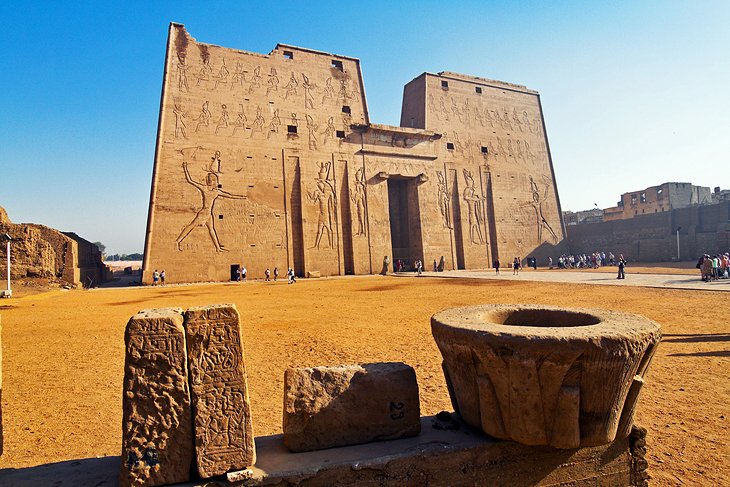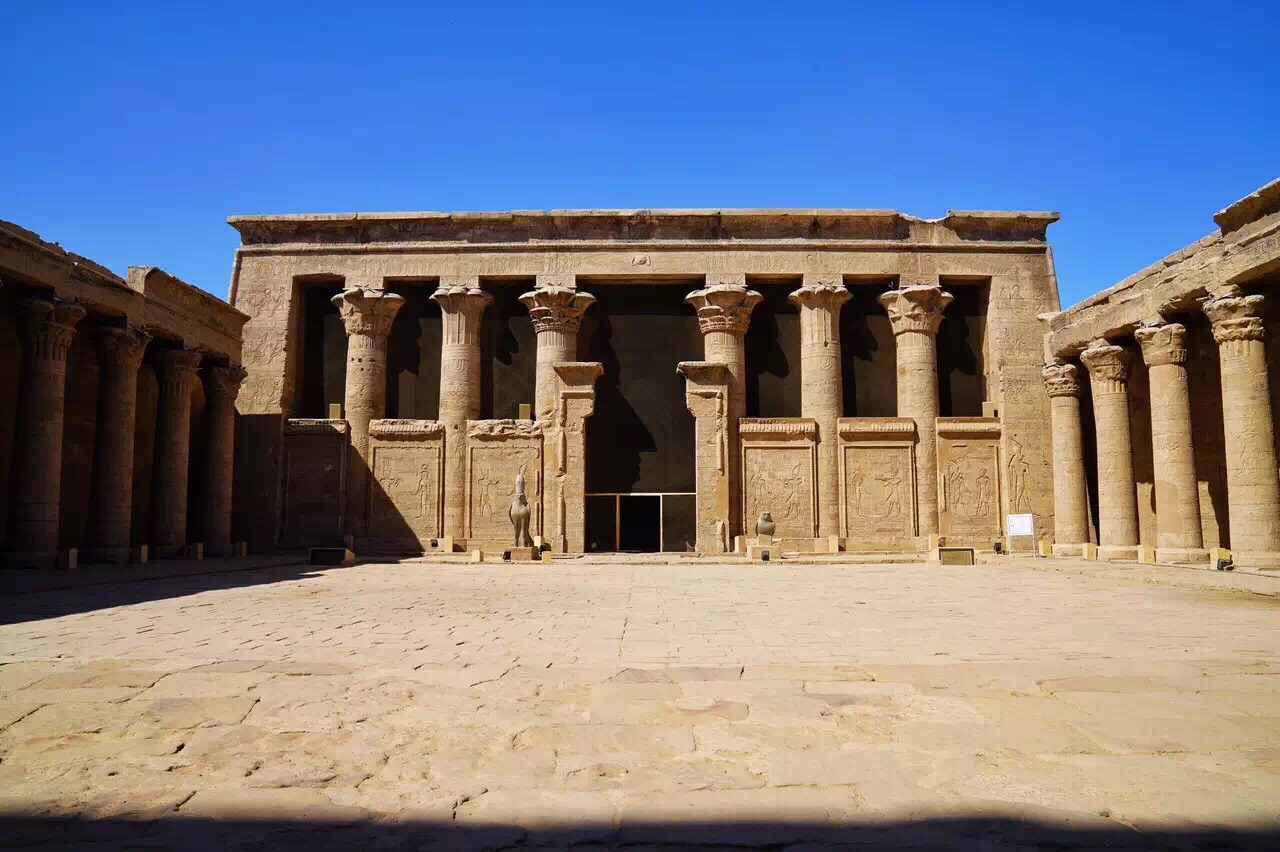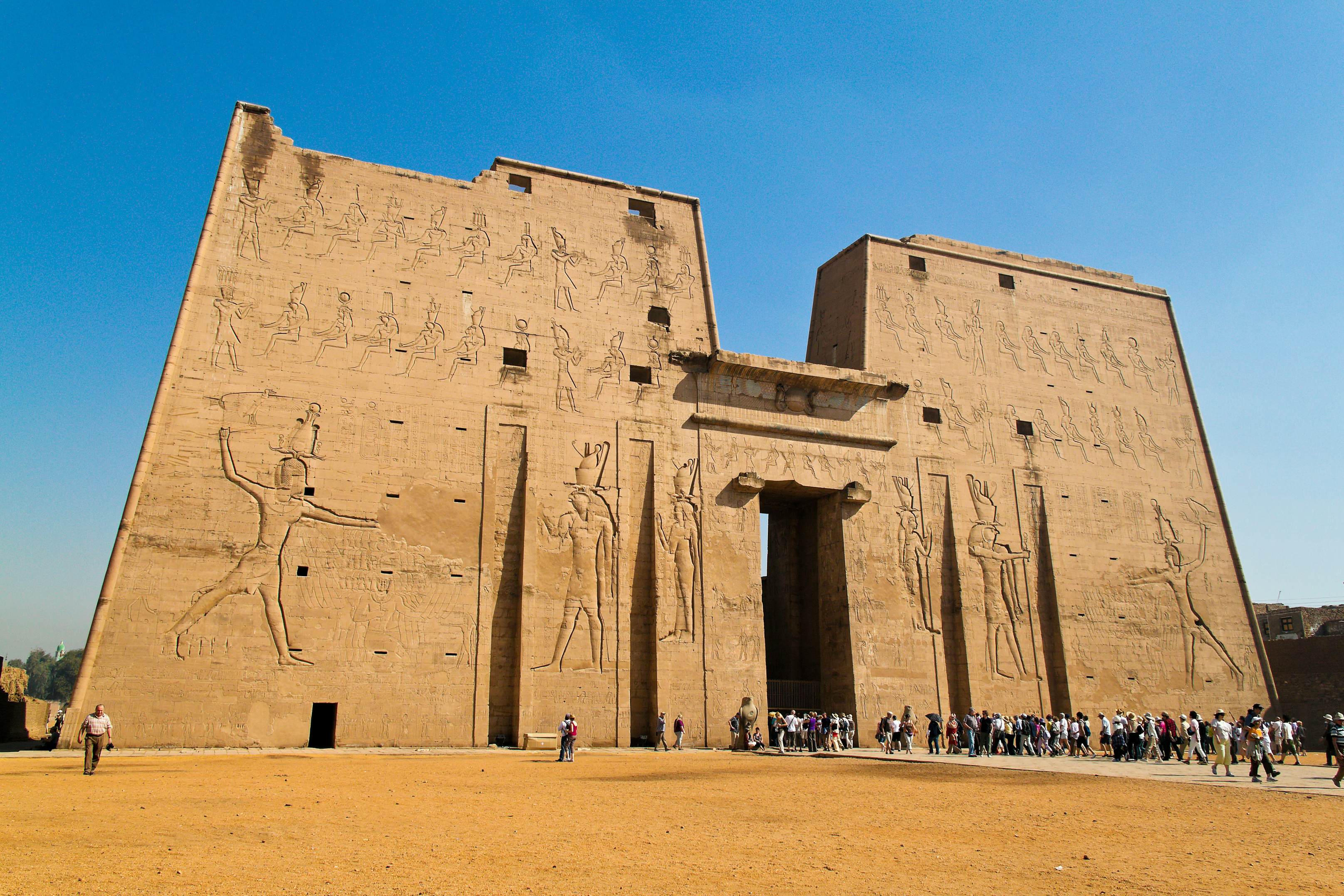The Temple of Horus at Edfu: A Journey Back in Time
Have you ever wished to travel back in time and witness the glory of ancient Egyptian architecture and religion? If you answer yes, then The Temple of Horus at Edfu is the perfect destination. This magnificent temple is a tribute to the falcon-headed god Horus, who was believed to be one of the most powerful gods in ancient Egypt. Located in the city of Edfu, this temple has stood the test of time and offers a rare glimpse into the history and culture of the ancient Egyptians. Join me on a journey back in time as we explore this enchanting temple and unravel the mysteries of its past.

Introduction to The Temple of Horus at Edfu
Are you ready to journey back in time to ancient Egypt? If so, visiting the Temple of Horus at Edfu is a must. Located on the west bank of the River Nile, halfway between the ports of Luxor and Aswan, this temple is one of the best-preserved in Egypt. It was commissioned by Ptolemy III Euergetes in 237 BC, dedicated to the falcon-headed sky god Horus, and completed in 57 BC during the reign of Cleopatra’s father, Ptolemy XII Auletes. Today, it is a testament to Egypt's fascinating history and architecture.
The Temple of Horus Edfu's incredible condition is due to two factors. Firstly, it was built much more recently than Egypt’s oldest pharaonic monuments, and secondly, it was filled with protective desert sand for centuries before its excavation in the mid-19th century. The result is a temple that is in remarkably good condition, providing visitors with a unique opportunity to see it as it might have looked over 2,000 years ago. The temple's size is also impressive, as it was the largest one dedicated to Horus's cult in Egypt.
The temple's rich inscriptions provide insight into Egyptian mythology, religion, and architecture during the Ptolemaic era. For example, the inscriptions on its walls provide important information on language, myth and religion during ancient Egypt. The Temple's inscribed building texts provide details of its construction and preserve information about the mythical interpretation of this and all other temples as the Island of Creation. The Sacred Drama, a recurring theme in ancient Egyptian mythology, is also depicted on the temple's walls. It involves the age-old conflict between Horus and Seth, which was believed to represent the struggle between good and evil.
The Temple of Horus at Edfu is also known for its impressive monumental gateway, which stands over 118 feet tall. It is flanked on either side by granite statues of Horus in his falcon form, and visitors enter the temple through this imposing gateway. The temple comprises a pillared hall, two transverse halls, and a barque sanctuary surrounded by chapels. Its architectural details provide an invaluable insight into building traditions that have since been lost at earlier temples like Luxor and Karnak.
Finally, the Temple of Horus at Edfu was essential in ancient Egyptian culture. It was the centre of several festivals sacred to Horus. Each year Hathor travelled south from her temple at Dendera to visit Horus at Edfu, and this event marking their sacred marriage was the occasion of a great festival and pilgrimage. These festivals and celebrations held in Horus's honour provide a glimpse into ancient Egyptians' religious practices and beliefs.
Visiting the Temple of Horus at Edfu is a journey back to ancient Egypt. Its impressive size, remarkable condition, and rich inscriptions offer valuable insight into Egyptian mythology, religion, and architecture during the Ptolemaic era. The temple's monumental gateway, architectural details, and festival's historical significance make it an unforgettable destination for anyone interested in ancient history and culture. [1][2]

Historical Background and Significance
The Temple of Horus at Edfu is one of Egypt's most well-preserved ancient monuments. Its captivating structure stands as an emblem of Edfu's rich historical narrative, offering a vibrant testament to Egypt's Ptolemaic era. Situated on the west bank of the Nile River in Upper Egypt, this magnificent structure uniquely blends cultural heritage and archaeological wealth that transports visitors through time.
The importance of the Temple of Horus lies in its religious devotion and architectural prowess, which encapsulates the traditions and rituals of the ancient Egyptians. Horus, the falcon-headed deity, held a significant place in ancient Egyptian cosmology and was often depicted as a protector and ruler of the land, embodying the pharaoh's power and legitimacy. The ancient Egyptians celebrated Horus in grand festivals, filling the temple with offerings and prayers and performing sacred rites that re-enacted his mythical battles.
Their devotion to Horus is evident in the grandiose pylons, intricate carvings, and sacred spaces that define the Temple of Horus. This well-preserved testament to the religious devotion of the ancient Egyptians offers visitors a deeply moving and tangible connection to the past. Exploring Edfu and the Temple of Horus opens a doorway into understanding the spiritual life and artistic expression of the ancient Egyptians, making it a truly invaluable experience.
Horus, one of the most significant deities in ancient Egyptian mythology, represents the sky and kingship. The temple reflects his celestial association, as he is often depicted as a man with a falcon's head or entirely as a falcon. His eyes represent the sun and the moon, reinforcing his celestial association. Horus is a central theme in Egyptian mythology, and the Pharaohs drew their legitimacy from their association with him. The Eye of Horus, a symbol of protection, good health, and royal power, is one of the widely-known symbols of ancient Egypt.
The Temple of Horus is a grand structure that stretches over an impressive 40,000 square meters and majestically rises from the heart of Edfu. The temple's elaborate entrance is flanked by two colossal statues of Horus, symbolising his continued veneration. This testament to his enduring veneration is also exquisite evidence of the architectural brilliance of the Ptolemaic era.
Visiting the Temple of Horus at Edfu can transport you back in time, and every stone whispers tales of pharaohs, gods, and ancient rituals. Exploring Edfu offers an unparalleled journey through time, where cultural heritage, archaeological wealth, and the timeless allure of the Nile are intertwined. With its historical significance and stunning architecture, the Temple of Horus at Edfu is one destination that should not be missed. [3][4]

How to Visit The Temple of Horus at Edfu
If you're planning a trip to Egypt, add the Temple of Horus at Edfu to your list of must-visit destinations. It is one of the largest and best-preserved temples dedicated to Horus and Hathor of Dendera. Here's how you can visit it:
The Temple of Horus at Edfu is located 109 km south of Luxor. It takes roughly 2 hours and 15 minutes to reach Edfu. The best way to get there is with a driver and tour guide. This option provides total flexibility, allowing you to decide how long you want to stay and what you want to see. You can ask your hotel for a bus tour to Edfu if you prefer a cheaper option. However, having a driver and tour guide may not give you as much flexibility.
Once you arrive in Edfu, the only way to get to the Temple of Horus at Edfu is by horse-drawn carriage. There are hundreds of carriages waiting for tourists to take them to visit the temple. Select a horse that looks well taken care of, and make sure to tip the owner. As tourists, we have the power to help and give employment to many people.
The Temple of Horus at Edfu is a large sandstone temple built during the Ptolemaic Period. It was started in 237 BC by Ptolemy III Euergetes I and finished over 180 years later, around 57 BC, by Ptolemy XII Neos Dionysos. The temple is considered Egypt's most complete and best-preserved ancient temple structure. The ancient Egyptians believed it was built on top of the location where the infamous battle of Horus and Seth took place.
Horus was worshipped as the falcon Horus of Behdet at the Temple of Edfu. He was usually depicted as a falcon or a falcon-headed man. The temple also features a pylon built by Ptolemy III's father in the first century BC, which leads into a peristyle court and then a hypostyle hall that precedes the sanctuary, the ultimate and most important part of the temple.
The Temple of Horus at Edfu replicates the standard layout of a pylon temple, which can be seen at many other sights around Egypt. However, it is the most complete example of this architectural style. Don't miss out on a visit to this impressive temple, and feel as though you've stepped back in time to experience ancient Egyptian culture and history. [5][6]

Transportation options to The Temple
Visiting the Temple of Horus at Edfu is essential to your Egypt itinerary. This guide will help you explore your transportation options to reach this ancient temple in the most convenient way possible.
To reach the Temple of Horus at Edfu, you must go to the city of Edfu, located 109km south of Luxor. The best way to get there is by booking a private driver with a tour guide. This option lets you choose how long you will stay and what you want to see. Your hotel in Luxor can arrange a driver and a guide for you, but it can be expensive.
You can ask your hotel for a bus tour to Edfu if you want a more affordable option. However, this option does not give you much flexibility, and you must follow a set itinerary. The bus will drop you off at Edfu, and you must take a horse-drawn carriage to reach the Temple of Horus at Edfu.
Once you reach the temple, you will find hundreds of horse-drawn carriages waiting for tourists. The roads leading to the temple are so narrow that no other vehicle can pass through, making a horse-drawn carriage the only transportation option available. Select a horse that looks well cared for, and don't forget to tip the owner.
The Temple of Horus at Edfu is a large sandstone temple dedicated to the falcon-headed god Horus. Built during the Ptolemaic period, it took over 180 years to complete. The temple is considered the most complete and best-preserved ancient temple structure in Egypt. The ancient Egyptians believed the temple was built on top of the location where the infamous battle of Horus and Seth took place.
The temple has a standard layout of a pylon temple, similar to other ruined temples around Egypt. The temple's large peristyle court and hypostyle hall lead to the most important part of the sanctuary, where the statue of Horus was kept.
Visiting the Temple of Horus at Edfu requires taking a horse-drawn carriage from Edfu. Your options to reach Edfu include booking a private driver and guide or joining a bus tour. Whichever option you choose, don't forget to tip your horse-drawn carriage driver and take care while selecting the horse. Visiting this temple will take you back in time to ancient Egypt, where you can explore this treasure's fascinating history and architecture. [7][8]

What to expect in a tour: timing and itinerary
A visit to the Temple of Horus at Edfu is an experience you should not miss on your trip to Egypt. Here's what you can expect on your tour of this ancient temple.
First, the temple is about 109 km south of Luxor. You can reach Edfu in around 2 hours and 15 minutes by car or bus. It's best to visit the temple with a driver and a tour guide, who can give you flexibility in timing and itinerary. Your hotel in Luxor can arrange a driver and a guide, or you can also opt for a bus tour if you're on a budget.
Once you reach Edfu, you'll have to take a horse-drawn carriage to get to the temple. The roads to the temple are narrow and don't support any vehicle. Although the horse-drawn carriage ride might not be comfortable for some, it's a unique experience as it gives employment to many people. However, select a horse that looks well taken care of and tip the owner of that horse.
The Temple of Horus at Edfu is famous for its large sandstone temple dedicated to the falcon-headed god Horus. The temple was built during the Ptolemaic Period, starting around 237 BC and finishing around 57 BC. It is considered the most complete and best-preserved ancient temple structure in Egypt. The ancient Egyptians believed the temple was built on top of the location where the infamous battle of Horus and Seth took place.
Inside the temple, you'll see beautiful, intricate carvings that glimpse ancient Egyptian mythology and history. However, expect the temple to be crowded, especially since it's a popular tourist destination. You'll encounter tour groups and vendors trying to sell their wares, so it's important to be patient and respectful.
Researching the temple before your visit is good, especially if you're planning to explore the temple on your own. You can also ask for a tour guide at the entrance of the temple, who can offer insights and explanations on the carvings and history of the temple.
In summary, visiting the Temple of Horus at Edfu can be an incredible experience, but it's important to be prepared for what to expect. With the right timing, planning, and attitude, you'll be able to appreciate the beauty and significance of this ancient temple fully. [9][10]
